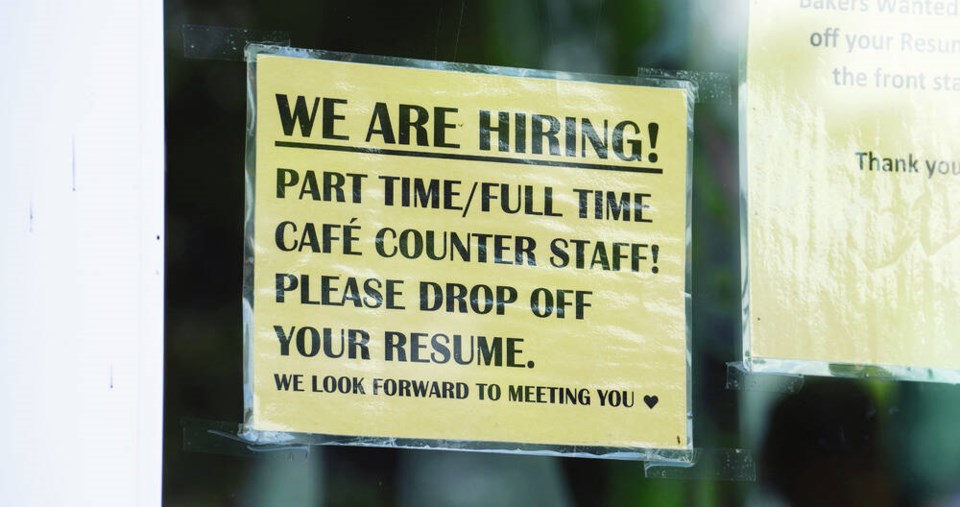Greater Victoria’s unemployment rate moved up slightly to 4.8 per cent in March from 4.3 per cent in February, but continued to be below the national level of 6.1 per cent.
The capital region’s labour force rose to 242,000 last month from 241,100 in February, Statistics Canada said in its monthly labour force report.
Greater Victoria employment rose in professional, scientific and technical services to 20,700 jobs last month from 18,500 in March 2023, the federal agency said.
Educational services moved up to 22,600 jobs from 18,100.
Wholesale and retail trade jobs increased to 32,100 from 27,400.
Declines were seen in manufacturing, which dropped to 7,600 jobs from 8,700 year-over-year. Health care and social services employment dropped to 33,900 jobs from 35,300.
Accommodation and food services also declined to 13,100 jobs in March from 17,200.
Brenda Bailey, B.C.’s Minister of Jobs, Economic Development and Innovation, said amid high interest rates and slower global economic growth, the province has added 75,000 jobs since March 2023.
B.C.’s unemployment rate came in at 5.5 per cent, the fourth-lowest among provinces, she noted.
She noted that all of B.C.’s March job gains are in full-time employment, and women’s increase in full-time employment was one of the highest among provinces at 6,700 jobs.
“British Columbia has also added the most self-employment jobs of any province since March 2023 at 33,300,” Bailey said.
Nationally, Canada’s unemployment rate jumped to 6.1 per cent in March as more people looked for work in an economy bogged down by high interest rates.
The labour force survey shows the figure is up from 5.8 per cent in February and marks the largest increase in the unemployment rate since summer 2022.
Employment was little changed last month, with the economy shedding 2,200 jobs, after modest increases over the last several months.
“The cracks that had been emerging within the Canadian labour market suddenly got a lot wider,” wrote CIBC’s executive director of economics, Andrew Grantham, in a client note.
The jump in unemployment comes as high borrowing costs weigh on businesses and strong population growth continues to add to the country’s labour supply.
The unemployment rate was up one percentage point on a year-over-year basis.
“The problem is that we got a slight decline in employment at a time when the population is still increasing, very, very quickly. And that was the main cause of concern within this report,” Grantham later said in an interview.
Youth are particularly feeling the chill in the labour market. Employment among those aged 15 to 24 declined by 28,000 in March and the jobless rate for the group rose to 12.6 per cent, the highest it’s been since September 2016 outside of 2020 and 2021.
A report from RBC released in January said students and new graduates rather than new arrivals to Canada are driving the increase in unemployment in the country.
“Close to half of the increase in the total number of unemployed people year-over-year in Canada … were students that were not in the job market and have started looking for work,” said Nathan Janzen, RBC’s assistant chief economist.
Friday’s report shows job losses last month were concentrated in accommodation and food services, followed by wholesale and retail trade and professional, scientific and technical services.
Meanwhile, employment increased in four industries, led by health care and social assistance.
Statistics Canada says the rise in the jobless rate was driven by an increase of 60,000 people searching for work or temporarily laid off.
The total number of unemployed people in the country stood at 1.3 million last month, an increase of nearly 250,000 compared with a year ago.
Despite weaker labour market conditions, wage growth continued to grow rapidly, with average hourly wages rising 5.1 per cent annually.
The job report is the last piece of major economic data the Bank of Canada has to consider ahead of its next interest rate decision on Wednesday.
Investors will be looking for any hints from the central bank on when it plans to begin lowering its key interest rate, which currently sits at five per cent.
Economists had been betting the Bank of Canada would deliver the first rate cut in June or July, however, after the latest jobs data, expectations are now leaning more toward June.
Grantham said he expects the central bank to signal rate cuts are imminent and point to the loosening labour market.
“We do think there’s going to be some hints there that interest rate cuts are close,” Grantham said.
>>> To comment on this article, write a letter to the editor: [email protected]



